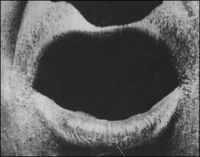Diglossia
From The Art and Popular Culture Encyclopedia
(Difference between revisions)
| Revision as of 21:35, 20 July 2014 Jahsonic (Talk | contribs) ← Previous diff |
Revision as of 21:36, 20 July 2014 Jahsonic (Talk | contribs) Next diff → |
||
| Line 2: | Line 2: | ||
| <small>Illustration: a close-up of a [[mouth]] in the film ''[[The Big Swallow]]'' (1901)</small>]] | <small>Illustration: a close-up of a [[mouth]] in the film ''[[The Big Swallow]]'' (1901)</small>]] | ||
| {{Template}} | {{Template}} | ||
| + | In [[linguistics]], '''diglossia''' ({{IPAc-en|d|aɪ|ˈ|ɡ|l|ɒ|s|i|ə}}; {{lang-el|διγλωσσία}} < {{lang|el|δι-}} [[prefix]] denoting two, from {{lang|el|δίς}}, twice + {{lang|el|γλῶσσα}}, language + {{lang|el|-ία}}, [[suffix]] denoting state or attribute, "speaking two languages") refers to a situation in which two [[dialects]] or usually closely related [[languages]] are used by a single language community. In addition to the community's everyday or [[vernacular]] language variety (labelled "L" or "low" variety), a second, highly codified variety (labelled "H" or "high") is used in certain situations such as literature, formal education, or other specific settings, but not used for ordinary conversation. | ||
| - | '''Speech ''' is the vocalized form of [[human communication]]. It is based upon the [[syntactic]] combination of [[Lexicon|lexical]]s and [[name]]s that are drawn from very large (usually about 10,000 different [[words]]) [[vocabulary|vocabularies]]. Each spoken word is created out of the [[phonetic]] combination of a limited set of [[vowel]] and [[consonant]] speech sound units. These vocabularies, the syntax which structures them, and their set of speech sound units differ, creating the existence of many thousands of different types of [[mutual intelligibility|mutually unintelligible]] human [[language]]s. Most human speakers are able to communicate in two or more of them, hence being [[Multilingualism|polyglot]]s. The vocal abilities that enable humans to produce speech also provide humans with the ability to [[singing|sing]]. | + | == See also == |
| - | + | * [[List of diglossic regions]] | |
| - | A gestural form of human communication exists for the [[deaf]] in the form of [[sign language]]. Speech in some [[culture]]s has become the basis of a [[written language]], often one that differs in its vocabulary, syntax and phonetics from its associated spoken one, a situation called [[diglossia]]. Speech in addition to its use in communication, it is suggested by some [[psychologist]]s such as [[Vygotsky]] is internally used by mental processes to enhance and organize [[cognition]] in the form of an [[Stream of consciousness (psychology)|interior monologue]]. | + | *[[Ausbausprache - Abstandsprache - Dachsprache]] |
| - | + | *[[Bilingualism]] | |
| - | Speech is researched in terms of the speech production and [[speech perception]] of the [[sounds]] used in [[vocal language]]. Other research topics concern [[speech repetition]], the ability to map heard spoken words into the vocalizations needed to recreated that plays a key role in the [[vocabulary]] expansion in [[children]] and [[speech error]]s. Several academic disciplines study these including [[acoustics]], [[psychology]], [[speech pathology]], [[linguistics]], [[cognitive science]], [[communication studies]], [[otolaryngology]] and [[computer science]]. Another area of research is how the [[human brain]] in its different areas such as the [[Broca's area]] and [[Wernicke's area]] underlies speech. | + | *[[Dialect continuum]] |
| - | + | *[[Digraphia]] | |
| - | It is controversial how far [[human]] speech is unique in that [[Animal language|other animals also communicate]] with vocalizations. While none in the [[wildness|wild]] have compatibly large vocabularies, research upon the nonverbal abilities of language trained [[apes]] such as [[Washoe (chimpanzee)|Washoe]] and [[Kanzi]] raises the possibility that they might have these capabilities. The [[origin of language|origins of speech]] are unknown and subject to much debate and [[speculation]]. | + | *[[Pluricentric language]] |
| - | + | *[[Register (sociolinguistics)]] | |
| - | ==See also== | + | *[[Sociolinguistics]] |
| - | :''See [[Phonocentrism]] '' | + | *[[Standard language]] |
| - | * [[Freedom of speech]] | + | *[[Linguistic insecurity]] |
| - | * [[Imagined speech]] | + | *[[Mixed language]] |
| - | * [[Index of linguistics articles]] | + | |
| - | * [[Sound symbolism]] | + | |
| - | * [[Talking bird]]s | + | |
| - | * [[Vocology]] | + | |
| - | * [[Public speaking]] | + | |
| {{GFDL}} | {{GFDL}} | ||
Revision as of 21:36, 20 July 2014

This page Diglossia is part of the linguistics series.
Illustration: a close-up of a mouth in the film The Big Swallow (1901)
Illustration: a close-up of a mouth in the film The Big Swallow (1901)
|
Related e |
|
Featured: |
In linguistics, diglossia (Template:IPAc-en; Template:Lang-el < Template:Lang prefix denoting two, from Template:Lang, twice + Template:Lang, language + Template:Lang, suffix denoting state or attribute, "speaking two languages") refers to a situation in which two dialects or usually closely related languages are used by a single language community. In addition to the community's everyday or vernacular language variety (labelled "L" or "low" variety), a second, highly codified variety (labelled "H" or "high") is used in certain situations such as literature, formal education, or other specific settings, but not used for ordinary conversation.
See also
- List of diglossic regions
- Ausbausprache - Abstandsprache - Dachsprache
- Bilingualism
- Dialect continuum
- Digraphia
- Pluricentric language
- Register (sociolinguistics)
- Sociolinguistics
- Standard language
- Linguistic insecurity
- Mixed language
Unless indicated otherwise, the text in this article is either based on Wikipedia article "Diglossia" or another language Wikipedia page thereof used under the terms of the GNU Free Documentation License; or on research by Jahsonic and friends. See Art and Popular Culture's copyright notice.

